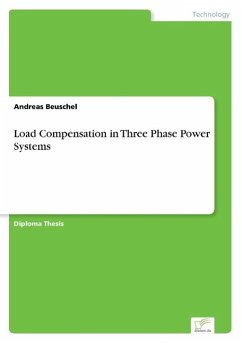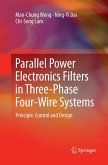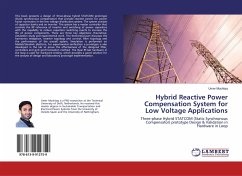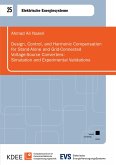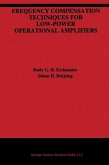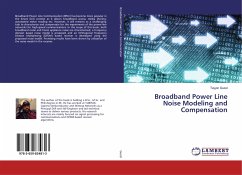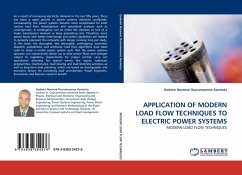Diploma Thesis from the year 2002 in the subject Electrotechnology, grade: 1,0, University of Applied Sciences Regensburg (Elektrotechnik), language: English, abstract: Inhaltsangabe:Abstract:
The object of this thesis is to design software and hardware to obtain the device parameters of a compensator. This compensator should restore the balance and the power factor of a three-phase three-wire system by using reactive elements only. The derived parameters should be accessible remotely and displayed on a PC.
L. S. Czarnecki recently presented a highly respected approach to derive the device parameters of the compensating susceptances. He defined the admittances Ye and A which represent the conditions in a three-phase system. He also suggested a way to derive these susceptances by measuring two line-to-line voltages and two line currents. The load balancing technique used in this project was based on Czarnecki s approach.
The first phase of the project concentrated on understanding and proving the theory behind the project by means of computer simulation.
The second phase of the project involved writing software for the DSP and building an interface to successfully task the requirements set by the theory. The aspect of being able to transfer the data to a PC via a modem-to-modem connection was taken into account too.
In the final stage it is shown that the implemented system is able to derive the necessary parameters in order to balance the currents and restore the power factor as supplied from mains. It was found that even though the supply from the University of Cape Town does not meet the requirements of the theory in terms of harmonic distortion, it is possible to achieve sufficient load balancing and power factor correction.
It was not possible to establish a reliable connection from one modem to the other because of the limitations of the telephone exchange system used at the University of Cape Town. The parts that are necessary forcommunication, however, were implemented and tested successfully. Therefore it was solely a reliable transmission of data that was unsuccessful and this was due to factors beyond the control or influence of the author.
Inhaltsverzeichnis:Table of Contents:
ERKLÄRUNGII
AcknowledgementsIII
Terms of ReferenceIV
SynopsisV
Table of ContentsVI
List of FiguresX
List of TablesXIII
GlossaryXIV
1Introduction1
1.1The Need for Load Compensation1
1.2The Thesis as a Part of a Project2
1.3Objectives of the Thesis2
2Theory for Balancing a Three-Phase Three-Wire System3
2.1Fictitious Impedance3
2.2Sufficient Condition for Balancing a Three-Phase Load5
2.2.1Compensator to Balance Currents6
2.2.2Compensator with Reactive Susceptances8
2.3Single-Phase Load as an Extreme Case of Imbalance9
2.4Resistive Single-Phase Load11
2.5Resistive and Reactive Load13
2.6Extension from an One-Phase to a Two-Phase Load15
2.7Further Equations16 16
.8Conclusion17
3Computer Simulations18
3.1Orcad18
3.2Matlab m-file21
3.3Simulink22
3.3.1Results of the Simulations23
aSingle Resistor23
bLoad with Three Resistors (unbalanced / symmetric)25
cLoad with Resistors and Reactances27
4Hardware Description30
4.1DSP TMS320F243 from Texas Instruments30
4.1.1Interrupts30
4.1.2Event Manager (EV2)32
4.1.3Digital Input / Output Ports (I/O)33
4.1.4Interfaces for Communication35
aSerial Communication Interface (SCI)35
bSerial Peripheral Interface (SPI)36
4.1.5Analog to Digital Converter (ADC)37
4.2Intelligent Liquid Crystal Display (LCD)39
4.3DSP Board41
4.3.1Digital to Analog Converter (DAC)42
4.4Interface Board43
4.5LEM-box45
4.6Phase Shifting Circuitry49
4.7Modems and their Usage50
4.7.1The Hyp...
The object of this thesis is to design software and hardware to obtain the device parameters of a compensator. This compensator should restore the balance and the power factor of a three-phase three-wire system by using reactive elements only. The derived parameters should be accessible remotely and displayed on a PC.
L. S. Czarnecki recently presented a highly respected approach to derive the device parameters of the compensating susceptances. He defined the admittances Ye and A which represent the conditions in a three-phase system. He also suggested a way to derive these susceptances by measuring two line-to-line voltages and two line currents. The load balancing technique used in this project was based on Czarnecki s approach.
The first phase of the project concentrated on understanding and proving the theory behind the project by means of computer simulation.
The second phase of the project involved writing software for the DSP and building an interface to successfully task the requirements set by the theory. The aspect of being able to transfer the data to a PC via a modem-to-modem connection was taken into account too.
In the final stage it is shown that the implemented system is able to derive the necessary parameters in order to balance the currents and restore the power factor as supplied from mains. It was found that even though the supply from the University of Cape Town does not meet the requirements of the theory in terms of harmonic distortion, it is possible to achieve sufficient load balancing and power factor correction.
It was not possible to establish a reliable connection from one modem to the other because of the limitations of the telephone exchange system used at the University of Cape Town. The parts that are necessary forcommunication, however, were implemented and tested successfully. Therefore it was solely a reliable transmission of data that was unsuccessful and this was due to factors beyond the control or influence of the author.
Inhaltsverzeichnis:Table of Contents:
ERKLÄRUNGII
AcknowledgementsIII
Terms of ReferenceIV
SynopsisV
Table of ContentsVI
List of FiguresX
List of TablesXIII
GlossaryXIV
1Introduction1
1.1The Need for Load Compensation1
1.2The Thesis as a Part of a Project2
1.3Objectives of the Thesis2
2Theory for Balancing a Three-Phase Three-Wire System3
2.1Fictitious Impedance3
2.2Sufficient Condition for Balancing a Three-Phase Load5
2.2.1Compensator to Balance Currents6
2.2.2Compensator with Reactive Susceptances8
2.3Single-Phase Load as an Extreme Case of Imbalance9
2.4Resistive Single-Phase Load11
2.5Resistive and Reactive Load13
2.6Extension from an One-Phase to a Two-Phase Load15
2.7Further Equations16 16
.8Conclusion17
3Computer Simulations18
3.1Orcad18
3.2Matlab m-file21
3.3Simulink22
3.3.1Results of the Simulations23
aSingle Resistor23
bLoad with Three Resistors (unbalanced / symmetric)25
cLoad with Resistors and Reactances27
4Hardware Description30
4.1DSP TMS320F243 from Texas Instruments30
4.1.1Interrupts30
4.1.2Event Manager (EV2)32
4.1.3Digital Input / Output Ports (I/O)33
4.1.4Interfaces for Communication35
aSerial Communication Interface (SCI)35
bSerial Peripheral Interface (SPI)36
4.1.5Analog to Digital Converter (ADC)37
4.2Intelligent Liquid Crystal Display (LCD)39
4.3DSP Board41
4.3.1Digital to Analog Converter (DAC)42
4.4Interface Board43
4.5LEM-box45
4.6Phase Shifting Circuitry49
4.7Modems and their Usage50
4.7.1The Hyp...
